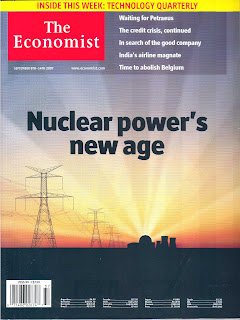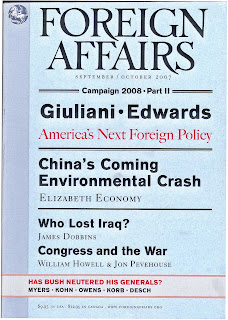Covering the crises
 Energy and climate change are in the news. More than that, these related issues are getting plenty of cover time on national magazines of late. Thus far it's impossible to tell if all this attention will mobilize the masses into action.
Energy and climate change are in the news. More than that, these related issues are getting plenty of cover time on national magazines of late. Thus far it's impossible to tell if all this attention will mobilize the masses into action.National Geographic must be given credit for being out front on the issue of climate change and energy for some time now. They've done a magnificent job in reaching out to the general public and providing accurate information in (as always) graphically interesting and accessible formats.
The current issue of NG now on the newsstands focuses on the controversies surrounding biofuels. Can they be produced sustainable?
"We can create ethanol in an incredibly dumb way," says Nathanael Greene, a senior researcher with the Natural Resources Defense Council. "But there are many pathways that get us a future full of wildlife, soil carbon, and across-the-board benefits." The key, Greene and others say, is to figure out how to make fuel from plant material other than food: cornstalks, prairie grasses, fast-growing trees, or even algae. That approach, combined with more efficient vehicles and communities, says Greene, "could eliminate our demand for gasoline by 2050."Judging by its cover and feature story for October 2007, Wired Magazine is apparently betting on switchgrass to emerge as the sustainable biofuel plant of choice.

"Cellulosic ethanol, in theory, is a much better bet. Most of the plant species suitable for producing this kind of ethanol — like switchgrass, a fast- growing plant found throughout the Great Plains, and farmed poplar trees — aren't food crops. And according to a joint study by the US Departments of Agriculture and Energy, we can sustainably grow more than 1 billion tons of such biomass on available farmland, using minimal fertilizer. In fact, about two-thirds of what we throw into our landfills today contains cellulose and thus potential fuel. Better still: Cellulosic ethanol yields roughly 80 percent more energy than is required to grow and convert it."The September 8th edition of The Economist turned its attention to an equally contentious topic: nuclear energy. As reported here a few months ago, the nuclear energy is poised to make a comeback by taking advantage of the concerns over climate change.

"The latest boost to nuclear has come from climate change. Nuclear power offers the possibility of large quantities of baseload electricity that is cleaner than coal, more secure than gas and more reliable than wind. And if cars switch from oil to electricity, the demand for power generated from carbon-free sources will increase still further. The industry's image is thus turning from black to green."Meanwhile,
"China has become a world leader in air and water pollution and land degradation and a top contributor to some of the world's most vexing global environmental problems, such as the illegal timber trade, marine pollution, and climate change. As China's pollution woes increase, so, too, do the risks to its economy, public health, social stability, and international reputation. As Pan Yue, a vice minister of China's State Environmental Protection Administration (SEPA), warned in 2005, "The [economic] miracle will end soon because the environment can no longer keep pace."

So writes Elizabeth Economy (great name) In "The Great Leap Backward?" featured in the October 2007 issue of Foreign Affairs.
 Time Magazine's October 1st issue covered the emerging scuffle in the Arctic over the oil and mineral rights beneath tits thawing ice. ("Warm War I?)
Time Magazine's October 1st issue covered the emerging scuffle in the Arctic over the oil and mineral rights beneath tits thawing ice. ("Warm War I?) "This summer, however, saw something new: for the first time in recorded history, the Northwest Passage was ice-free all the way from the Pacific to the Atlantic. The Arctic ice cap's loss through melting this year was 10 times the recent annual average, amounting to an area greater than that of Texas and New Mexico combined. The Arctic has never been immune from politics; during the Cold War, U.S. and Soviet submarines navigated its frigid waters. But now that global warming has rendered the Arctic more accessible than ever — and yet at the same time more fragile — a new frenzy has broken out for control of the trade routes at the top of the world and the riches that nations hope and believe may lie beneath the ice. Just as 150 years ago, when Russia and Britain fought for control of central Asia, it is tempting to think that — not on the steppe or dusty mountains but in the icy wastes of the frozen north — a new Great Game is afoot."Finally, if all of the above leaves you confused, overwhelmed or depressed (or maybe "all of the above"), the August edition of Popular Science with its emphasis on"Engineering A Better Earth" may be a source of optimism with its ideas of how society may pull itself out of the hole it's dug for itself.

"Then again, maybe not. (GW)"Wrap thawing glaciers in football-field-size synthetic blankets that will keep the cold in and the heat out. At least that's what ski resorts in the Swiss Alps are doing. Tired of rising the fate of their industry on the global community's ability to get a grip on rapid climate change, more than a dozen resorts turned to local textile company Fritz Landolt to stop the melting. Called the Ice Protector, Landolt's material is a tough, but lightweight dual-layer composite. On top is polyester to reflect ultraviolet light, and on the bottom is polypropylene, a polymer used in military clothing and auto parts to block heat. When wrapped around a
glacier, it prevents the top snow layer -- and it's hoped, the permanent ice underneath -- from melting in the summer sun.

0 Comments:
Post a Comment
<< Home